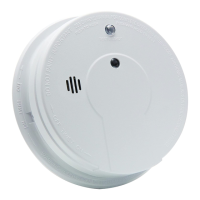5. NUISANCE ALARMS
Smoke alarms are designed to minimize nuisance alarms.
Cigarette smoke will not normally set off the alarm, unless the
smoke is blown directly into the alarm. Combustion particles from
cooking may set off the alarm if the alarm is located close to the
cooking area. Large quantities of combustible particles are gener-
ated from spills or when broiling. Using the fan on a range hood
which vents to the outside (non-recirculating type) will also help
remove these combustible products from the kitchen.
If the alarm does sound, check for fires first. If a fire is discovered,
get out and call the fire department. If no fire is present, check
to see if one of the reasons listed in section 2 may have caused
the alarm. The Model P12040 has a “HUSH” control that is
extremely useful in a kitchen area or other areas prone to nuisance
alarms. For more information refer to section 4, OPERATION AND
TESTING.
6. MAINTENANCE
IF TAMPER RESIST PIN HAS BEEN USED, REFER TO TAMPER
RESIST LOCKING PIN IN SECTION 3 FOR PIN REMOVAL
INSTRUCTIONS.
To replace the battery, remove the alarm from the trim ring by
rotating the alarm in the direction of the “OFF” arrow on the
cover (see Section 3, Figure 7) To disconnect the A.C. power
harness, squeeze the locking arms on the sides of the Quick con-
nector while pulling the connector away from the bottom of the
alarm (see Section 3, Figure 6).
BATTERY INSTALLATION AND REMOVAL
To replace or install the batteries, you must first remove the alarm
from the trim ring by following the ALARM REMOVAL instructions
at the beginning of this section. After alarm has been removed,
you can open the battery door and install or replace the battery.
Battery installation instructions are provided on the inside of the
battery door.
FIGURE 9
1375-7213-00(21008164-EN A).indd 101375-7213-00(21008164-EN A).indd 10 2010.10.7 2:06:25 PM2010.10.7 2:06:25 PM

